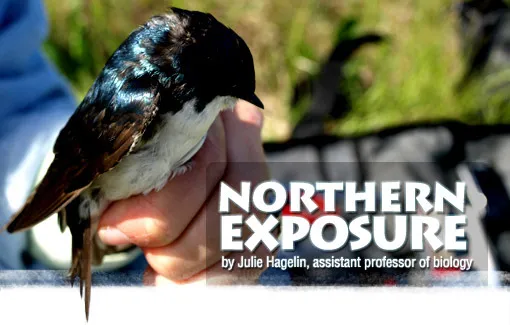Northern Exposure


Assistant Professor of Biology Julie Hagelin is an expert on avian behavioral ecology and avian communication. She has conducted extensive research on chemical signaling of the Crested Auklet, an Alaskan seabird that produces a remarkable tangerine-like scent, as well as on the perfumed and critically endangered Kakapo parrot of New Zealand. Write to her at jhageli1@swarthmore.edu.

Tree Swallows and Climate Change
Ashley, funded by a summer research stipend from the Howard Hughes Medical Institute, was in charge of a long-term nest-box study of tree swallows in cooperation with the Alaska Bird Observatory (ABO) in Fairbanks, Alaska. Ashley coordinated ABO's swallow program for elementary through high-school students and led student groups that studied Tree Swallow nesting activity. The observatory owns over 100 nest boxes in local fields and the education program has monitored breeding at this site for over a decade. Consequently the data are quite valuable for understanding how behavior of breeding birds in Alaska may be affected by global warming.

Ashley Miniet '10 (right) coordinated ABO's swallow program for elementary through high-school students and led student groups that studied Tree Swallow nesting activity.
Ashley also examined the long-term Tree Swallow dataset and, building on the work of Daisy Yuhas '09, has confirmed that the birds in central Alaska are breeding earlier and earlier each year. The pattern coincides with warmer summer weather that tends to occur earlier each season. She also discovered that birds that follow the early-breeding pattern most markedly are those that are more likely to experience nest failure. The exact mechanisms behind the discovery are unclear, but ABO ornithologists are interested in understanding the important result in more detail.

Ashley examines a swallow chick.
Meredyth, funded by a summer stipend from Swarthmore's Natural Science and Engineering Division, assisted me in uncovering basic questions about the sense of smell in birds. Olfaction in birds is a sensory modality long overlooked by ornithologists and a subject that is yielding new insights into avian behavior. The abundance and accessibility of Tree Swallows in Alaska make them an ideal species to examine closely.
The swallow study developed out of a recent discovery made by my Behavioral Ecology seminar. Students found that domestic chicks detected and retained familiarity with environmental odors that they had experienced while still inside the egg. Specifically, students revealed that newly hatched birds that had developed in incubators containing scent were not particularly responsive to the scent after hatching, compared to a control group (that had developed in an incubator without scent). It was as if the scent-treated group had become familiar with the odor and therefore responded less when they experienced it again after they had emerged from the egg.

Meredyth Duncan '12, who took all of the field photos included here, builds new swallow boxes. photo by Eric Engman
On the University of Alaska campus (not far from the Alaska Bird Observatory), Meredyth monitored another set of Tree Swallow nest boxes, each of which had a small tube of peppermint oil attached inside. Adult swallows built their nest, laid eggs, and reared chicks in the minty surroundings. By contrast, the nest boxes at ABO contained no mint oil. When hatchlings at both sites were nine days old, the students tested their response to mint odor. The protocol involved holding each nestling in a warm, specially-made swallow “sleeping bag” until it closed its eyes and fell asleep, while gently puffing scented air near into the bird's nostrils (known as nares) with a squeeze bottle. The degree to which a bird responded by clapping its beak, squirming, or shaking its head was scored. Such behavior is a measure of how potent a bird found the odor to be.

Newly-hatched swallow chicks in a nesting box.
An Alaskan Extravaganza

Julie and Ashley check on a swallow nest box.
During the ten-week Alaskan experience, the two Swatties not only enjoyed many different adventures, they developed and honed skills in research design, bird monitoring, handling, and scientific data analysis. On one occasion a moose even joined us at the field site while it quietly browsed on tender willow shoots and grass - both of which sounded delicious!



